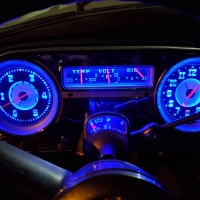Timing by a Vacuum Gauge
I know this subject has been discussed in the past, and I even remember printing out the details on paper for future reference. Well, the future is here, and I hope to get my Hudson dialed in this weekend, and wanted to check my tune using my vacuum gauge. Of course, I can't find that instructions I'd printed out earlier, and a search of this forum doesn't turn up anything either. How exactly does one do this? Thanks in advance for the help. Doug
0
Comments
-
simply put you will have the highest vacuum reading at the optimum timing setting for your engine. Loosen distributor and slowly move it while watching the vacuum gauge for highest reading. If car has an advance unit it should be unhooked and vacuum source plugged,
Roger0 -
Can you attach the vacuum guage to the hose you pulled off the vacuum advance and use that as the vacuum source?0
-
For tuning you need a manifold vacuum source. As far as I know, stepdown-wise, the carburetors give a ported signal (above the throttle plate) to the advance.0
-
Also from my previous experience, turn the distributor until you get the maximum vacuum but then turn it down 1 or 2 inches. Some cars will ping if you leave it at maximum vacuum setting. At least that was the case on my '46 super six.0
-
Greaser, did you forget about the w'shield wiper hose connection?0
-
Park, that's a good spot, right at the intake.0
-
Get a timing light and do it right.0
-
Rod you are correct in that the factory specs are not nessasarily the optimum vacuum setting. Due to variables in fuel / air that can cause things like "Ping". Or other objectionable results that may cause engine damage. I should have elaborated a little more I suppose.
Hudson specs take into account the owner is going to buy the cheapest gas he can find in general. So the car is engineered to run good on crap gas and great on good stuff,
Roger0 -
Going back to the 1960's, maybe even the 1950's anybody on here old enough to remember a neat little gadget you could buy for $19.95 from an ad in Popular Mechanics or Mechanics Illustrated called a Multi-tune (as I recall). It was a square box about 12 x 12 by 6 inches and you used it to electronically tune your car. Had a slide switch to select 6 or 8 cylinder cars and inside were all sorts of marvelous things such as diodes and capacitors and I don't remember what else. As I recall it had a circuit board in there - I think that would have been one of the very early uses of circuit boards. Today they could put the package in a small size compact instrument. I used that meter for years tuning my cars.
Hudsonly,
Alex Burr
Memphis, TN0 -
Hi Alex, is this what you are talking about? I still use this today to set the dwell since I understand that is much more accurate than setting the gap on the points. It's great for setting idle rpm as well.
Jairo0 -
Speaking of such things (I have one of those boxes ... a Sears "Engine Analyzer") . . . does anyone know of a currently available dwell meter that will work on a 6v car? My timing light works OK by just connecting a 6v "lantern battery" in series with the car's battery, but I can't get the analyzer/dwell meter to operate that way.0
-
Jairo, the one I had is similar - except the wires came out the back and it had no tray at the bottom. Functions about the same also. The one I bought was just a plain gray box, but the dial was very similar. Yours may be a later version of the one I had.
Hudsonly,
Alex Burr
Memphis, TN0 -
Hi Alex,
After reading your description I knew I had one alike and went searching for it on an old tool box. How about this...
These are great tools from back in the day.0 -
Park_W, I have a Dixco dwell meter/tach like JMed's and I have used it to tune my Hudson. It's been awhile but I believe I switched the lead on the coil and used a 12 volt lawn mower battery to power the meter, grounding the battery to the car. Not sure why your's isn't working.0
-
That's close JMed - still not the one. The one I had was a gray square box, about 12 x 12 x 6 inches deep. The switches appear to be the same. The dial was at the top and, as I recall, there were two rotary switches plus a slide switch (at the bottom) to select 6 or 8 cyl. The wires came out the back.
Alex B0 -
The tune-up meter that JMed shows in his picture is a Heathkit model ID-28 automotive tune up meter. I assembled mine years ago and still use it and have the manual for it. This will work on both 6 and 12 volts and needs no external supply. It has been a rugged unit and I recently bought a second on the auction site to use with my distributor machine. Bruce0
This discussion has been closed.
Categories
- 36.9K All Categories
- 112 Hudson 1916 - 1929
- 20 Upcoming Events
- 92 Essex Super 6
- 28.6K HUDSON
- 571 "How To" - Skills, mechanical and other wise
- 995 Street Rods
- 151 American Motors
- 178 The Flathead Forum
- 49 Manuals, etc,.
- 78 Hudson 8
- 44 FORUM - Instructions and Tips on using the forum
- 2.8K CLASSIFIEDS
- 608 Vehicles
- 2.1K Parts & Pieces
- 77 Literature & Memorabilia
- Hudson 1916 - 1929 Yahoo Groups Archived Photos



